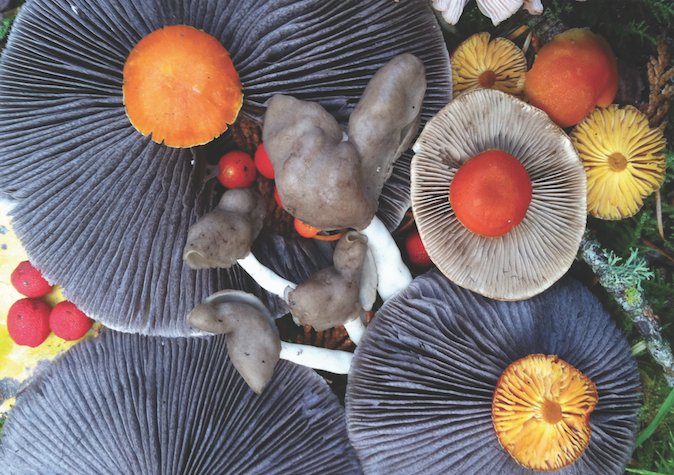 They were the first multicellular organisms to emerge from the oceans and take hold on dry land.
They were the first multicellular organisms to emerge from the oceans and take hold on dry land.
They’ve lived and thrived for eons, molding every environment they touch. They’ve survived ice ages, extinctions, and the most extreme conditions this planet can generate. They underpin the great Web of Life—a web in which we humans are but a thread. “They” are fungi, and they’re the subject of a fascinating new film that reveals much about their vast but little understood kingdom.
Visually magnificent, emotionally touching, and intellectually challenging, Fantastic Fungi explores the fundamental role that mushrooms, molds, and the like have had in shaping the world as we know it. The film also posits the hopeful message that fungi can help us solve some of our most vexing problems.
Fantastic Fungi bursts with director Louie Schwartzberg’s time-elapse clips of mushrooms—minute and massive, elegant and eccentric, sublime and scary—emerging from every imaginable matrix. Schwartzberg’s stunning cinematography inspires child-like glee at witnessing the miracle of life, while also offering a window into its deeper workings.
The Great Transformers
Mushrooms, as the movie clearly demonstrates, are the great transformers. They bridge death and life, chaos and form, energy and substance. They are a cosmos unto themselves, ancient and—according to some experts—sentient.
We and our animal kin are simply the most recent dwellers in a world that fungi played a major role in crafting.
If that strikes you as poetic fancy, consider that fungi, which appeared on land roughly 1.3 billion years ago, produce oxalic acid that can dissolve and transform rock, allowing these fast-growing organisms to sequester calcium and other minerals. Over time, they cause rock to crumble, turning it into soil and creating the matrix for the plant kingdom. They did this eons ago, and they do so today.
Fungal mycelium—the fibrous vegetative part of a fungal colony—is capable of holding up to 30,000 times its own mass of carbon and water. This makes mycelial biomass an essential component of healthy, fertile, erosion-resistant soil.
Fungi are the consummate survivors. They need no sunlight, but can absorb and transform other forms of radiation. This is how they outlived the great darkness that blanketed the earth following the cataclysmic asteroid impact during the Cretaceous-Paleogene period. They set the stage for the emergence of plants and animals on land.
Animals branched off from the fungal kingdom a mere 640 million years ago. As Earthlings, the fungi are almost a billion years ahead of us.
Not only are they the oldest organisms on terra firma, they’re also the most abundant, explains science and food writer Eugenia Bone, one of the many fungal experts interviewed in the film.
There are over 1.5 million species of fungi. Only 20,000 produce what we know of as mushrooms, says Bone, adding that mushrooms are neither vegetables nor animals. “They’re somewhere in between.”
Mycophiles & Mycophobes
From reverence to revulsion, human attitudes toward fungi vary widely among individuals and cultures.
Asian, Slavic, and Meso-American cultures, for example, tend to be deeply “mycophilic.” Mushrooms and other fungi are valued as food and prized for their medicinal—and in some cases psychotropic—properties. They figure prominently in their art and folklore. Other cultures, especially the English and English-influenced ones, tend to be “mycophobic,” partly because some species are poisonous.
But fungal aversion runs deeper than fear of the relatively few toxic varieties. Bone believes it stems from the intimate way that fungi mediate death and decay, a point vividly demonstrated by one of Schwartzberg’s astonishing sequences depicting the fungal engulfment and decomposition of a dead rodent on the forest floor.
“They’re there at the very end of life, but because of this, they’re also at the very beginning of life, transforming what is old and dead into elemental raw materials for new life,” says Bone.
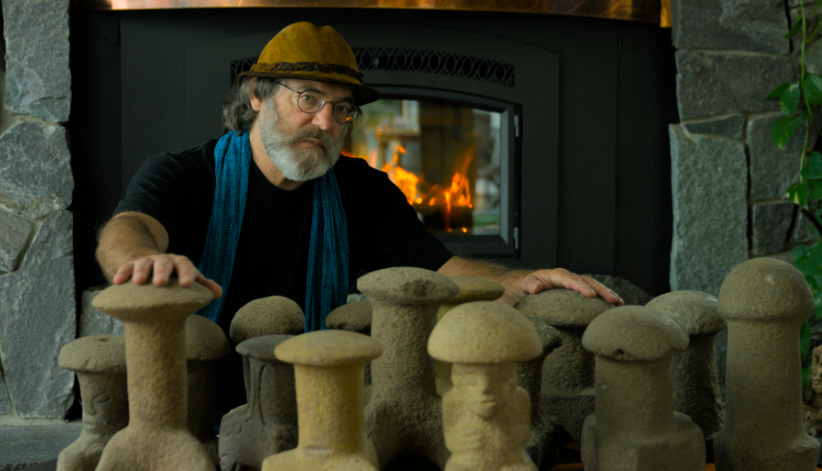 Fungi of one sort or another can break down nearly anything that is carbon-based. That, says myco-entrepreneur Paul Stamets, is why they can play a key role in land remediation, and ultimately, ecosystem restoration.
Fungi of one sort or another can break down nearly anything that is carbon-based. That, says myco-entrepreneur Paul Stamets, is why they can play a key role in land remediation, and ultimately, ecosystem restoration.
A self-taught citizen-scientist in the spirit of Darwin and Audubon, Stamets has been involved in a number of demonstration projects using fungi to clean up land contaminated by oil spills.
In one such experiment, researchers compared four massive dirt mounds saturated with diesel & petroleum waste. One was left untreated; one was treated with degradative enzymes; one with petroleum-eating bacteria; and the fourth seeded with Oyster mushroom (Pleurotus) mycelium.
This fungus produces peroxidase enzymes that break carbon-hydrogen bonds, enabling the fungus to break down and assimilate the hydrocarbons from oil and petroleum distillates.
At the end of the experiment, three of the four piles were basically dead and inert; remediation was marginal at best. The fourth was covered with hundreds of pounds of Oyster mushrooms, some quite large. “They sporulated, the spores attracted insects, which laid eggs, which begat larvae, which then attracted birds that brought in seeds. In a short time it was an oasis of life.”
The findings led to the development of “bunker spawn”—large burlap sacks filled with mycelium plus storm-borne debris. These can be used for habitat restoration along polluted streams or land contaminated by oil spills. Not only do they absorb and transform petroleum, they also decrease coliform bacteria.
Alongside the mushrooms themselves, Paul Stamets is the undisputed star of Fantastic Fungi, and with good reason. Through his compelling lectures, big-picture thinking, and eminently practical mushroom solutions to urgent problems (pollution cleanup, insect infestations, bee colony health) he has done more to popularize fungi than anyone since Alexander Fleming and his Penicillium mold.
Stamets transformed his teenage fascination with mushrooms into multiple patentable discoveries, and two thriving companies that employ hundreds. Fungi Perfecti purveys all sorts of things related to foraging, cultivating, and eating mushrooms. Host Defense is an offshoot that sells condition-specific supplement formulas derived from Reishi, Turkey Tail, Lion’s Mane, Agarikon, and other medicinal mushrooms.
The Language of Nature
“The task we face today is to understand the language of nature. I believe nature is intelligent. The fact that we lack the language skills to understand nature does not impugn the idea that nature is intelligent,” Stamets says in the film.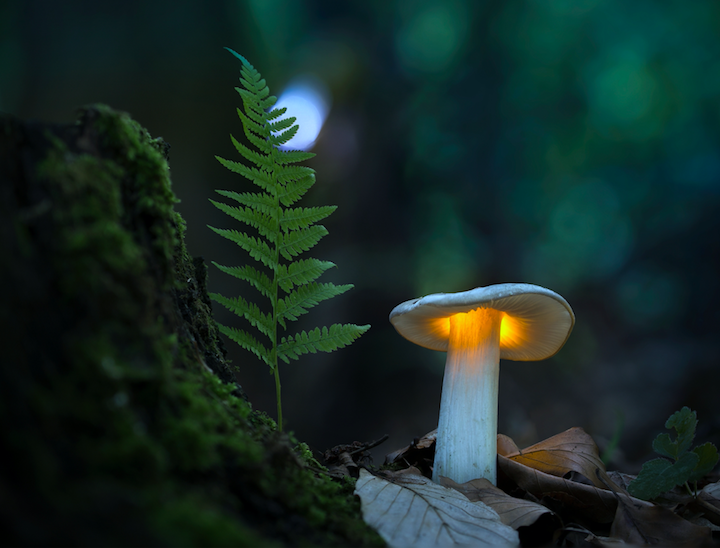
A former logger who spends as much time as possible in the forests of the Pacific Northwest, Stamets believes the vast and largely invisible underground network of fungal mycelium is nature’s original worldwide web. It’s a communication system, enabling the speedy transfer of biochemical information over long distances.
He points to the similarities between the network architecture of mycelial masses, of the human nervous system, and of its ultimate externalization as the computer-based internet. All three are comprised of non-centralized, highly interconnected units able to send and receive messages in multiple directions.
This fungal proto-internet is another of Stamets’ ideas that smacks of New Age nature romance. But there’s growing evidence to support it. We now know, for example, that trees are able to send chemical signals to each other via the fungal mycelial networks interwoven with their roots, as forest ecologist Suzanne Simard explains in the film.
Issues around communication and social interaction have deep personal resonance for Stamets. Though he is an eloquent adult, he had a terrible stutter as a child, which ostracized him from his peers. The problem persisted despite years of speech therapy. It was an experience with fungi that unlocked his ability to speak.
Coming of age in a small, conservative Ohio town during the heady early 1970s, Stamets says it was his older brother John who kindled his interest in mushrooms, particularly the psychotropic varieties described by R. Gordon Wasson in his seminal 1957 LIFE magazine article, “Seeking the Magic Mushroom.”
Wasson introduced post-war US pop culture to Psilocybe mexicana and the indigenous healing rituals surrounding it.
Inspired by his brother, the younger Stamets soon discovered researchers like Charles T. Tart and Andrew Weil. Their descriptions of the states induced by ingesting psilocybin opened a window to a rippling colorful landscape that Stamets was eager to explore.
He acquired a bag of Psilocybin mushrooms and, knowing nothing about dosing, naively ate them all. He soon found himself literally up a tree, in the middle of a rainstorm, hallucinating wildly. Overwhelmed by fear, he suddenly became very clear, remembered his speech problem, and began repeating the phrase “Stop stuttering now!” over and over in his mind.
The next morning, he was able to speak normally. Stamets credits the mushrooms with freeing him from social isolation.
Science & Psychedelics
Fantastic Fungi explores the re-emergence of serious research on the therapeutic use of Psilocybin—a subject all but banished from the halls of science following the Nixon administration’s declaration of “war on drugs.”
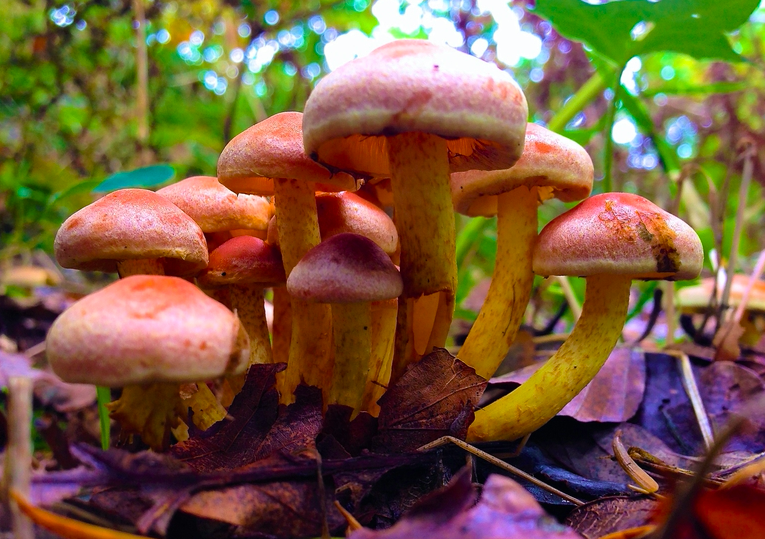 But over the last decade, the staggering consequences of opioid addiction, depression, and PTSD, combined with a growing recognition that indigenous cultures do indeed have great healing wisdom, has led some researchers to reconsider psychotropics like psilocybin and ayahuasca.
But over the last decade, the staggering consequences of opioid addiction, depression, and PTSD, combined with a growing recognition that indigenous cultures do indeed have great healing wisdom, has led some researchers to reconsider psychotropics like psilocybin and ayahuasca.
This movement recently hit a new peak with the announcement that a small group of private donors has granted $17 million to Johns Hopkins School of Medicine to found a new Center for Psychedelic and Consciousness Research.
The first and largest such institution in the world, this new center is taking a broad, cross-disciplinary look at the ways in which psilocybin and other psychedelic substances affect the human brain, consciousness, behavior, and health.
Roland Griffiths, professor of behavioral biology in Hopkins’ Department of Psychiatry and Behavioral Sciences, will head the endeavor, which has drawn some of the leading lights in modern psychedelic research, including Mary Cosimano, MSW, Bob Jesse, PhD, and William Richards, PhD. All are spotlighted in Fantastic Fungi, as are other prominent researchers like Anthony Bossis, PhD, at NY Langone Medical Center.
The Hopkins center will conduct studies of psychedelic medicines for opioid and alcohol addiction, Alzheimer’s disease, PTSD, anorexia nervosa, major depression, Lyme disease syndrome, and in the palliative care of people with cancer and other life-threatening illnesses.
The latter topic—the experience of cancer patients during and after experiencing psilocybin—provides some of the film’s most poignant moments.
Toxins & Remedies
“Why do mushrooms produce molecules that fit receptors in the human body?” Andrew Weil asks in Fantastic Fungi. A longtime friend and colleague of Paul Stamets’, Weil says this is an inevitable question for anyone who gives a moment’s thought to the ancient relationship between fungi and people.
One could also flip that question: Why does the human nervous system produce receptors tailor-made for certain fungal compounds?
The renaissance of psychedelic research at mainstream institutions like Hopkins and NYU will go a long way toward raising the credibility of the field. But it does not legalize it. Psilocybin and all other psychotropic plants are still illegal in all 50 states. The cities of Denver, CO, and Portland, OR, have decriminalized—though not legalized—psilocybin but not other psychedelic plants. Chicago is considering a similar move.
While psychedelic research is the most controversial and headline-grabbing aspect of mushroom science, in reality only a small number of fungi produce psychotropic compounds. Psychedelics are but a very small part of the mushroom story.
“Fungi are constantly in competition with other fungi, bacteria, and plants for nutrients. They produce lots of different compounds to protect themselves and ensure their access to the resources they need,” Stamets says. “Our best antibiotics come from fungi.”
Some fungi, like Trametes versicolor (Turkey Tail)—a common sight on any woodland hike—produce polysaccharides that may help fight against certain type s of cancer. Others, like the rare and massive Agarikon (Lariciformes officinalis) make compounds that block viral pathogens.
s of cancer. Others, like the rare and massive Agarikon (Lariciformes officinalis) make compounds that block viral pathogens.
Stamets has identified Agarikon-derived substances active against pox viruses, including the one that causes smallpox, as well as various strains of human influenza. His pox discoveries attracted the attention of the Department of Defense’s Bioshield program as a potential countermeasure against weaponized pox viruses.
Then, there are “entomopathogenic” fungi—they kill insects. The most flamboyant of these is Cordyceps, a prized genus of Asian medicinal mushrooms that overtake various types of insects, gradually replace their tissues with mycelium, and then burst forth with caterpillar-shaped fruiting bodies.
Stamets and his team have been able to tweak the biology of a species of Metarhizium fungi—another entomopath—to create a so-called “trojan-horse” fungus that can destroy entire nests of harmful insects such as termites and carpenter ants. He’s currently working on fungal fixes for pests like bedbugs and mosquitos.
Saving Bees
But fungi can also save insects, particularly bees. Entomologist Walter S. “Steve” Sheppard at Washington State University has been working closely with Stamets and his team on studies of extracts from Ganoderma (Reishi) and Fomes (Amadou) fungi to combat Deformed Wing Virus. DWV is a lethal bee infection thought to be a major factor in the worldwide collapse of honeybee colonies.
Their field trial, published last year in the Nature subsidiary journal, Scientific Reports, showed a 79-fold reduction of DWV in honey bee colonies fed on sucrose syrup infused with Ganoderma extract.
Given the rapid spread of colony collapse, and the fact that roughly two-thirds of the human global food supply depends upon plants pollinated by bees, findings like this have profound relevance for the future of our food chain.
Stamets’ companies are committed to solving the problem. Through their “Give Bees a Chance” give-back program, Host Defense and Fungi Perfecti have channeled more than $5 million to WSU’s Honey Bee & Pollinator division.
Wonder & Awe
Fantastic Fungi is the culmination of 13 years’ worth of work, and it is a high point in Louie Schwartzberg’s distinguished filmmaking career, which includes Netflix’ groundbreaking Moving Art series, Mysteries of the Unseen World, and Disney’s Wings of Life.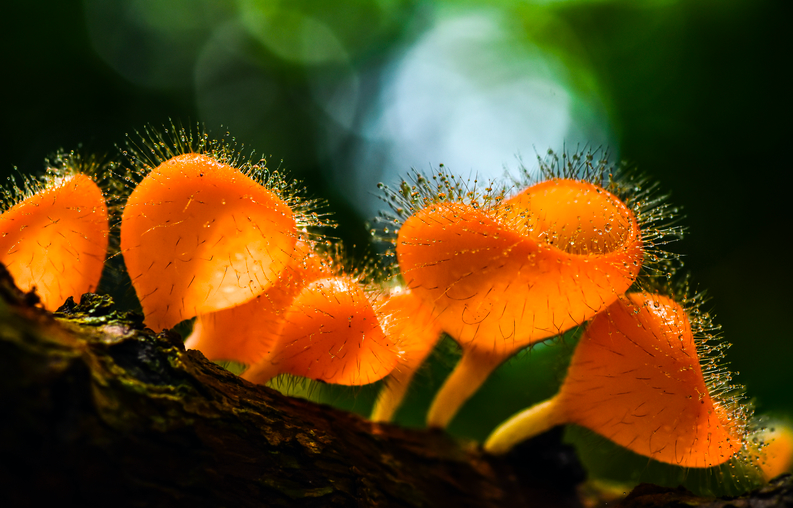
He has also contributed to dozens of top feature films like The Bourne Ultimatum, Men in Black, Jerry Maguire, and classics like Altered States and Koyaanisqatsi.
Schwartzberg has had cameras going 24/7 for nearly 40 years, making time-elapsed recordings of the natural world. He sums up his life’s aim with a single word: Wonder.
“We experience wonder by truly seeing the world around us. Wonder and awe allow us to transcend the ordinary.”
Fantastic Fungi accomplishes this objective and then-some. It opens us to a magnificent realm that is always underfoot, always around us doing its quiet work, largely overlooked by our dazzled and distracted eyes.
The movie celebrates the interconnectedness of all beings, and offers a hopeful message that by tuning in and humbly learning from this planet’s most ancient inhabitants, we may yet redeem ourselves from the predicaments we have created.
Fantastic Fungi is currently screening in dozens of independent theaters across the US, as well as via real-time online group screenings. The producers stress that the film is meant to be viewed in community. They hope that Fantastic Fungi will create its own “mycelial” network of like-minded viewers who resonate with its message.
END







